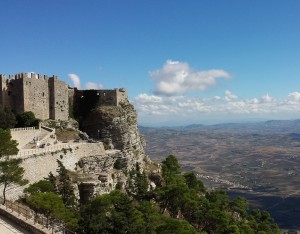On Sicily’s Streets, A View To Kill
Younger visitors might immediately compare Erice with the home of the Volturi vampire coven in Stephanie Meyer’s Twilight series. One can certainly imagine obsidian-robed figures flitting about the shadows to perform dark rituals at black masses. The bloodsuckers may have actually lived in the Tuscan town of Volterra (while the 2009 film adaptation was shot in Montepulciano), but the appropriateness of Erice as a haven for the undead to make their abode is uncanny. Even along the main roads, it is eerily quiet.
Cultic history aside, what Erice really has going for it is a view literally to die for. From the town’s dizzying overlooks, there are virtually endless vistas of land and sea. Trapani lies to the west and south, its crescent beach and salt pans lapped by the Mediterranean. To the north, the limestone slopes of another lonely peak, Monte Cofano, and stands as a silent companion to the Tyrrhenian Sea below.
Winding through the mazelike passageways that crisscross the town like cracks that appear on a window when struck by a rock, the imagination quickly conjures images of Tolkien or C.S. Lewis thanks to curtained windows, pots of succulents, green doors and brass knockers that add an even more otherworldly touch to the remarkably litter-free streets. It was remarkable to realize real people (rather than Bilbo Baggins) lived here.
Noon rolling around, we headed down Via Vittorio Emanuele — which qualifies as something of a main thoroughfare in Erice, with even enough space for a single Smart Car to squeeze by — to La Prima Dea. Twinned to a famous coffee bar and pastry shop across the street, the intimate eatery boasts a traditional Sicilian menu using only local ingredients and an authentic hole-in-the-wall feel that fools one into thinking they’ve stepped into someone’s home rather than a commercial restaurant. The restaurant was founded in the early 1950s, but in 1965 was taken over by Michael Cavasino who, year after year, sought to introduce new recipes to its considerable menu — a mission now currently headed by successor Alessandro Cavasino. Plain tile covers the second floor, with but a few tables to sit at near the small wooden bar and (what else?) stone walls. I tucked into the gnocchetti Mediterraneo, an ingenious pasta dish with tomatoes, green pesto, plenty of cheese and a not insignificant amount of pistachios. The nuts and wheat-based pasta complemented each other as seamlessly as a pair of figure skaters, swirling together with the pesto, tomatoes and cheese in a refined choreography that both teased and satisfied the taste buds. Some may argue that restaurants in areas not unknown to tourists may deliberately serve small portions in an effort to make one buy more, but here they were more than enough. Kesi had the couscous al araba, an Arabian-style couscous with mixed vegetables and meat which is said to be one of the most underrated gastronomic specialties of Sicily. Taking a bite, it was certainly drier than my pasta, but also blended perfectly.
The two of us shared a half-liter of a local red wine, which tasted like liquid la dolce vita. Strong and full-bodied, in one sip it was clear why Italian reds are among the best in the world. What was the bill for all this, plus a starter of bread with butter that tasted like a soft cheese, you ask? Just 33 euros (about $44.74), including a three euro fee to sit down (standard throughout much of Italy).
While good food may be a definite plus, great road trips are about just that: the road. Stomachs full and a bit more exploring in Erice and the nearby Eremo La Casa Del Sorriso — a converted Capuchin monastery set in woodland on the slopes of Mount Erice, home to a centuries-old library where it’s not uncommon to see black-robed monks or priests flit about the white-washed halls decorated with images of the Virgin Mary — and it was off to San Vito Lo Capo. Famous for the crystalline water of the Mediterranean Sea along with over a mile and a half (3 kilometers) of fine gold sand beach, the coastal area on the extreme northwest tip of Sicily may be among the most underrated beaches in all of Europe, if not the world. Arriving in this paradise of sand and surf is all the more spectacular when considering the journey to get there involves passing through a desert-like area known locally as Purgatorio.
The town itself was a bit crowded for our liking, so we opted for a spot a few minutes to the south. No sooner had we parked near the gently lapping waves, we were racing full speed toward the sapphire water. Feet making contact with the liquid, which roughly 90 percent of our bodies is composed of, a surprising shock of cold blossomed up the legs and throughout the rest of the body. Wasn’t the Mediterranean supposed to be almost blood warm?
The great thing about the human body, though, is its ability to adapt, and a few teeth-chattering minutes later the low temperature was all but forgotten. Rising high and tumbling with the waves that rose about two meters (6.5 feet) with each swell, if the day’s driving was the ice cream sundae, then this was the cherry on top. With the beach all but empty (try finding that anywhere else in Italy!), the last rays of the setting sun set upon the distant hills, lighting them aflame in brilliant golden orange shades. Was this heaven on earth? Perhaps, but more than that, it was illumination — on a place, an individual, a friendship.
That, and it warmed the soft sand much more than an October day had a right to be.

Featured image: With a sweeping view of much of northwestern Sicily, the Venus Castle is one of the most underrated in Italy. Photo Credit: Kesi Sundaralingam/GALO Magazine.

